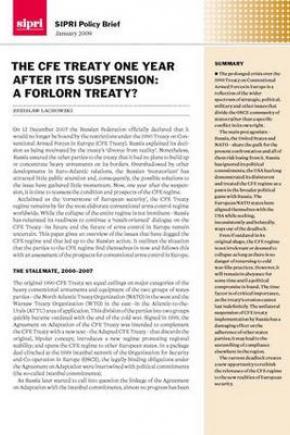The CFE Treaty one year after its unilateral suspension: a forlorn treaty?
Download this SIPRI Policy Brief
Summary
The prolonged crisis over the 1990 Treaty on Conventional Armed Forces in Europe is a reflection of the wider spectrum of strategic, political, military and other issues that divide the OSCE community of states rather than a specific conflict in its own right.
The main protagonists—Russia, the United States and NATO—share the guilt for the present confrontation and all of them risk losing from it. Russia has ignored its political commitments; the USA has long demonstrated its disinterest and treated the CFE regime as a pawn in the broader political game with Russia. The European NATO states have aligned themselves with the USA while seeking, inconsistently and belatedly, ways out of the deadlock.
Even if outdated in its original shape, the CFE regime is not irrelevant or doomed to collapse as long as there is no danger of returning to cold war-like practices. However, it will remain in abeyance for some time until a political compromise is found. The time factor is of critical importance, as the treaty’s erosion cannot last indefinitely. The unilateral suspension of CFE treaty implementation by Russia has a damaging effect on the adherence of other states parties; it may lead to the unravelling of compliance elsewhere in the region.
The current deadlock creates a new opportunity to rethink the relevance of the CFE regime to the new realities of European security.
About the author
Dr Zdzislaw Lachowski (Poland) is a Senior Fellow with the SIPRI Euro-Atlantic Security Programme. He specializes in research on European security and arms control as well as on European politico-military integration. His recent publications include Foreign Military Bases in Eurasia, SIPRI Policy Paper no. 18 (June 2007) and Tools for Building Confidence on the Korean Peninsula (June 2007). He has also contributed to the SIPRI Yearbook since 1992.

